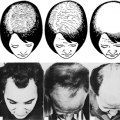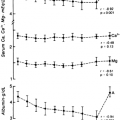TREATMENT
Part of “CHAPTER 65 – PAGET DISEASE OF BONE“
Issues regarding therapy for Paget disease include questions about the indications for specific medical treatment, anticipated benefits from these treatments, choices among the antipagetic agents, and the utility of nonspecific therapies (e.g., analgesics, nonsteroidal antiinflammatory drugs). In patients with a range of signs and symptoms, the localized nature of this disorder makes highly individualized treatment decisions necessary.
The goals of treatment are to relieve symptoms and to attempt to prevent future complications. The currently available therapies for Paget disease in the United States include the bisphosphonate agents etidronate, pamidronate, alendronate, tiludronate, and risedronate, as well as salmon calcitonin and plicamycin. All appear to act by decreasing osteoclastic bone resorption. The first-choice therapy is a potent bisphosphonate, but parenteral salmon calcitonin may be an alternative for patients who are not candidates for bisphosphonate therapy. Plicamycin has largely been replaced by the potent newer bis-phosphonates, especially intravenous pamidronate. Initial and early reductions in the levels of urinary resorption markers, followed by decreases in serum alkaline phosphatase (reflecting a subsequent slowing of new bone formation) nearly always result from appropriate treatment with these agents. Consequently, a variety of pagetic symptoms may be ameliorated. Moreover, bone biopsies taken before and after courses of treatment provide evidence for normalization of bone morphology (see Fig. 65-4B). Thus, the goal of relieving symptoms is one that often can be met. Some data suggest that the prevention of future complications through an arrest or slowing of active pagetic bone turnover may be possible in some patients, especially with the newer bisphosphonates that have the capacity to achieve a biochemical remission for extended periods of time in most patients.42
Therefore, the indications for treatment include (a) symptoms referable to Paget disease and (b) asymptomatic but active involvement (i.e., associated with elevated bone turnover markers) in areas of the skeleton where future serious complications might arise. Examples of this second indication include marked skull or vertebral involvement, which carries the threat of future neurologic problems; involvement of bones adjacent to major joints, such as the hip, knee, or ankle, with the potential for disabling joint problems; or pagetic change in a long bone, particularly in the lower extremity, so that a future bowing deformity is possible with disease progression over time. These issues are especially important in younger patients who may live with the disorder for many years. On the other hand, a small area of pagetic change in the calvarium or asymptomatic disease in the pelvis not involving the hip joint may be observed without treatment, particularly in elderly patients.
The kinds of symptoms that are likely to respond to treatment also must be considered. The early clinical trials with bisphosphonates made it clear that a substantial placebo effect occurs from virtually any therapy. However, when the experience with treatment is analyzed carefully, several points become apparent. The reduction in the activity of Paget disease often decreases bone pain, pagetic headache, excessive warmth, some arthritic complaints, and, in some instances, the signs and symptoms associated with neurologic compression syndromes. In the relatively rare patient with high-output cardiac failure associated with extensive Paget disease (usually a person with underlying heart disease), treatment of the Paget disease may lead to some amelioration of cardiac symptoms. Hearing loss would not be expected to reverse itself (although progression might be slowed), bowed limbs may continue to bow with weight-bearing, and severely narrowed joint spaces will remain arthritic, although perhaps become less painful.
BISPHOSPHONATES
Five bisphosphonate compounds are used to treat Paget disease in the United States, including the first oral agent used for the disorder, etidronate; the only intravenous preparation, pamidronate; and three newer oral agents, tiludronate, alendronate, and risedronate. These are discussed in the order in which they became available.
Etidronate.
Etidronate became available at approximately the same time as salmon calcitonin.43,44 Indeed, these two agents were the mainstays of therapy for this disorder for nearly 20 years, after which the newer and more potent bisphosphonates emerged. Etidronate is given orally at a dose of 5 mg/kg per day (400 mg in most patients), taken with a small amount of water or clear juice at a point midway through a 4-hour fast (e.g., between two meals at least 4 hours apart or at bedtime at least 2 hours after any food has been ingested). It is given for a treatment course of 6 months’ duration, typically achieving ˜50% reduction in elevated indices of pagetic bone turnover in most patients, as well as a relief of those symptoms likely to respond to decreased turnover as previously noted. Thus, in patients with mild disease, indices may return to normal and remain that way with continued symptom relief for several years after a single 6-month course.45 However, individuals with initial elevations of serum alkaline phosphatase more than three to four times the upper limit of normal typically continue to have biochemically elevated turnover indices despite the 50% or so reduction, even if symptoms improve. Such patients are typically retreated at the same dose in repeated cycles of 6 months on, 6 months off therapy, a program that has maintained a reduced level of turnover for up to 10 years in some patients,45 although others have experienced a loss of effectiveness with repeated cycles.46
The failure of indices to return to normal or near normal in most of the more severely affected patients has been suggested as one explanation for the finding of disease progression in many patients treated with etidronate.47 Interestingly, higher dosages of etidronate for longer treatment intervals produce greater degrees of biochemical suppression than the recommended regimen, but clearly such therapy often leads to clinically significant osteomalacia.43 This is the basis for the recommendation that the 400-mg dose be given for no longer than 6 months, followed by at least a 6-month etidronate-free interval, an approach that is generally quite safe. All bisphosphonates have the capacity to impair mineralization of newly forming bone if enough is given for a long enough time period (the process reverses itself once the agent is stopped), but, of the currently available bisphosphonates, only etidronate at excessive dosages is likely to do so. Etidronate has also been shown to be associated with progression of lytic disease in some patients with this manifestation of the disorder48; thus, the drug should not be used in individuals with advancing lytic disease in weight-bearing bone or in patients with healing fractures. As is noted later, the newer bisphosphonates do not appear to impair mineralization at the therapeutic doses that are highly effective in treating this disease.
Stay updated, free articles. Join our Telegram channel

Full access? Get Clinical Tree





